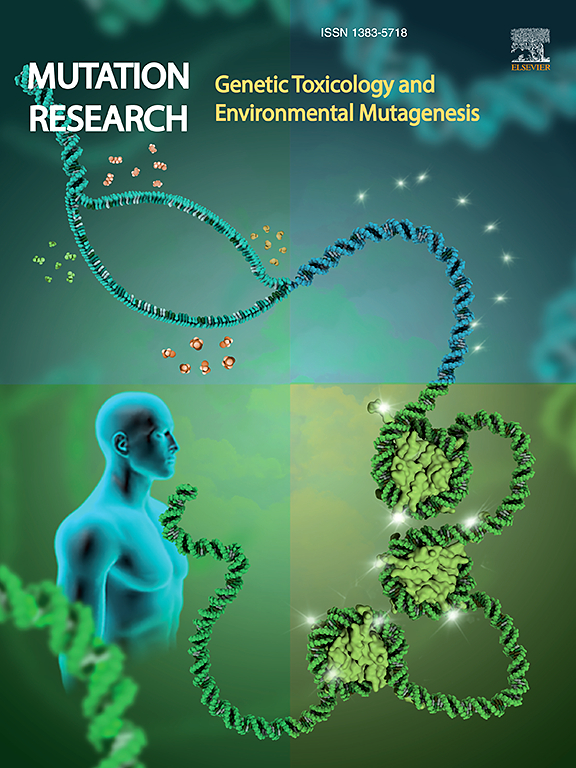DNA修复基因的上位相互作用作为农药暴露农业工人DNA损伤易感性的生物标志物
IF 2.5
4区 医学
Q3 BIOTECHNOLOGY & APPLIED MICROBIOLOGY
Mutation research. Genetic toxicology and environmental mutagenesis
Pub Date : 2025-08-01
DOI:10.1016/j.mrgentox.2025.503880
引用次数: 0
摘要
一些职业性农药暴露与DNA单链断裂(SSBs)、DNA双链断裂(DSBs)修复、DNA加合物形成或DNA-DNA和DNA-蛋白质交联引起的遗传毒性有关。编码DNA修复途径酶的基因多态性可能调节个体对农药遗传毒性的易感性。本研究共纳入450名受试者,其中包括225名接触复杂农药混合物的农业工人和225名来自印度西北部旁遮普省的非接触对照者。采用Kruskal-Wallis试验检测OGG1 Ser326Cys (C1245G)、XRCC1 Arg194Trp (C26304T)、XRCC1 Arg399Gln (G28152A)、XPC Lys939Gln (A2920C)、XPC Ala499Val (C21151T)、XPD Asp312Asn (G23591A)、XPD Lys715Gln (A35931C)、XPF Arg415Gln (G1244A)、XPG Asp1104His (G3507C)、ERCC1 Asn118Asn (C354T)基因多态性与农药诱导DNA损伤的易感性。通过方差分析研究上位性基因相互作用与DNA损伤的关系。结果表明,变异OGG1 326Ser/Cys基因型与XRCC1 194Arg/Trp和XRCC1 399Arg/Gln基因型的交互作用显著增加了DNA损伤的易感性。XPC 939Gln/Gln基因型与XPC 499Ala/Val、XPD 312Asp/Asp和XPD 715Gln/Gln基因型显著相互作用,增加DNA损伤易感性。在暴露的XPF 415Gln/Gln个体中,变异XPG Asp/His和ERCC1 8092CA基因型个体的DNA损伤显著更高。我们观察到在DNA修复途径中调节DNA损伤的一些具有统计学意义的epistatic基因相互作用,这可能被用作印度西北部旁遮普省农药暴露农业工人的易感性生物标志物。本文章由计算机程序翻译,如有差异,请以英文原文为准。
Epistatic interactions in DNA repair genes as biomarkers of susceptibility for DNA damage in pesticide-exposed agricultural workers of Punjab, North-West India
Some occupational exposures to pesticides have been associated with genotoxicity which arises from DNA single-strand breaks (SSBs), repair of DNA double-strand breaks (DSBs), DNA adduct formation, or DNA-DNA and DNA-protein cross-links. Polymorphisms in genes encoding enzymes of DNA repair pathways may modulate the individual’s susceptibility to pesticide-induced genotoxicity. A total of 450 subjects were included in this study, which comprises 225 agricultural workers exposed to complex mixtures of pesticides and 225 non-exposed controls from Punjab, North-West India. Susceptibility of OGG1 Ser326Cys (C1245G), XRCC1 Arg194Trp (C26304T), XRCC1 Arg399Gln (G28152A), XPC Lys939Gln (A2920C), XPC Ala499Val (C21151T), XPD Asp312Asn (G23591A), XPD Lys715Gln (A35931C), XPF Arg415Gln (G1244A), XPG Asp1104His (G3507C), ERCC1 3′-UTR (C8092A) and ERCC1 Asn118Asn (C354T) gene polymorphisms with pesticide-induced DNA damage was determined by Kruskal-Wallis test. The association of epistatic gene interactions with DNA damage was studied by ANOVA. The results indicated significant interactions of variant OGG1 326Ser/Cys genotype with XRCC1 194Arg/Trp and XRCC1 399Arg/Gln genotypes in increased susceptibility to DNA damage. XPC 939Gln/Gln genotype significantly interacts with XPC 499Ala/Val, XPD 312Asp/Asp and XPD 715Gln/Gln variant genotypes to increase DNA damage susceptibility. Among exposed XPF 415Gln/Gln individuals, DNA damage was significantly higher in those individuals who had variant XPG Asp/His and ERCC1 8092CA genotypes. We observed some statistically significant epistatic gene interactions in DNA repair pathways in modulating DNA damage, which may be used as biomarkers of susceptibility in pesticide-exposed agricultural workers of Punjab, North-West India.
求助全文
通过发布文献求助,成功后即可免费获取论文全文。
去求助
来源期刊
CiteScore
3.80
自引率
5.30%
发文量
84
审稿时长
105 days
期刊介绍:
Mutation Research - Genetic Toxicology and Environmental Mutagenesis (MRGTEM) publishes papers advancing knowledge in the field of genetic toxicology. Papers are welcomed in the following areas:
New developments in genotoxicity testing of chemical agents (e.g. improvements in methodology of assay systems and interpretation of results).
Alternatives to and refinement of the use of animals in genotoxicity testing.
Nano-genotoxicology, the study of genotoxicity hazards and risks related to novel man-made nanomaterials.
Studies of epigenetic changes in relation to genotoxic effects.
The use of structure-activity relationships in predicting genotoxic effects.
The isolation and chemical characterization of novel environmental mutagens.
The measurement of genotoxic effects in human populations, when accompanied by quantitative measurements of environmental or occupational exposures.
The application of novel technologies for assessing the hazard and risks associated with genotoxic substances (e.g. OMICS or other high-throughput approaches to genotoxicity testing).
MRGTEM is now accepting submissions for a new section of the journal: Current Topics in Genotoxicity Testing, that will be dedicated to the discussion of current issues relating to design, interpretation and strategic use of genotoxicity tests. This section is envisaged to include discussions relating to the development of new international testing guidelines, but also to wider topics in the field. The evaluation of contrasting or opposing viewpoints is welcomed as long as the presentation is in accordance with the journal''s aims, scope, and policies.

 求助内容:
求助内容: 应助结果提醒方式:
应助结果提醒方式:


